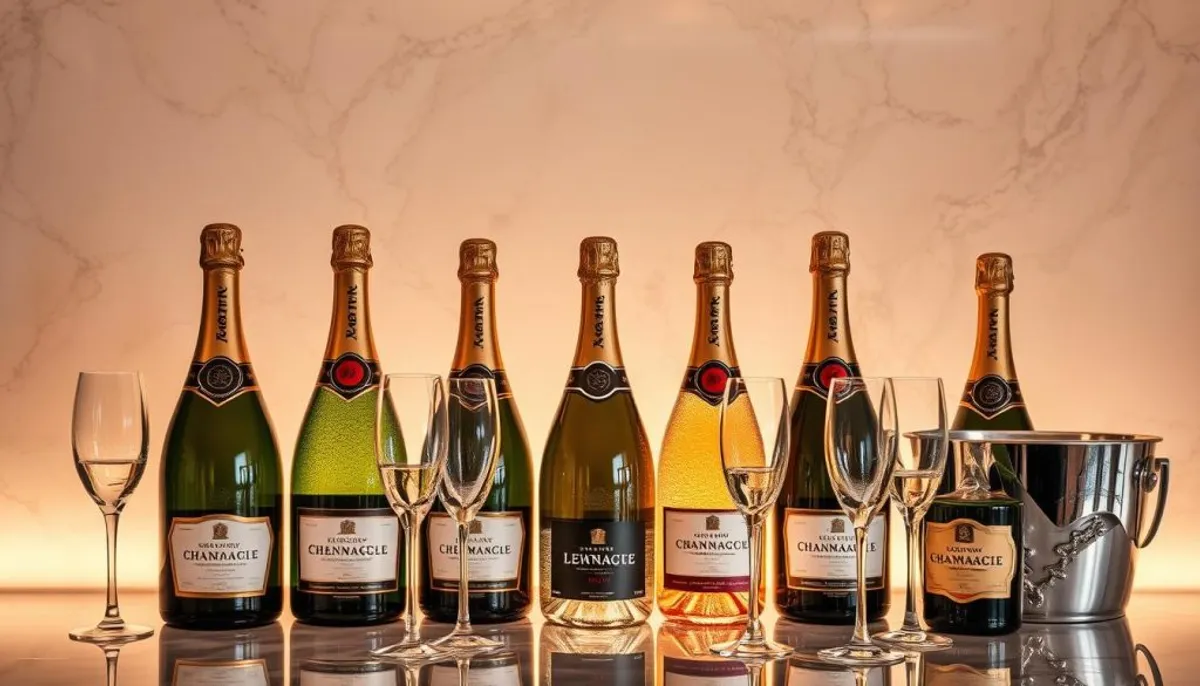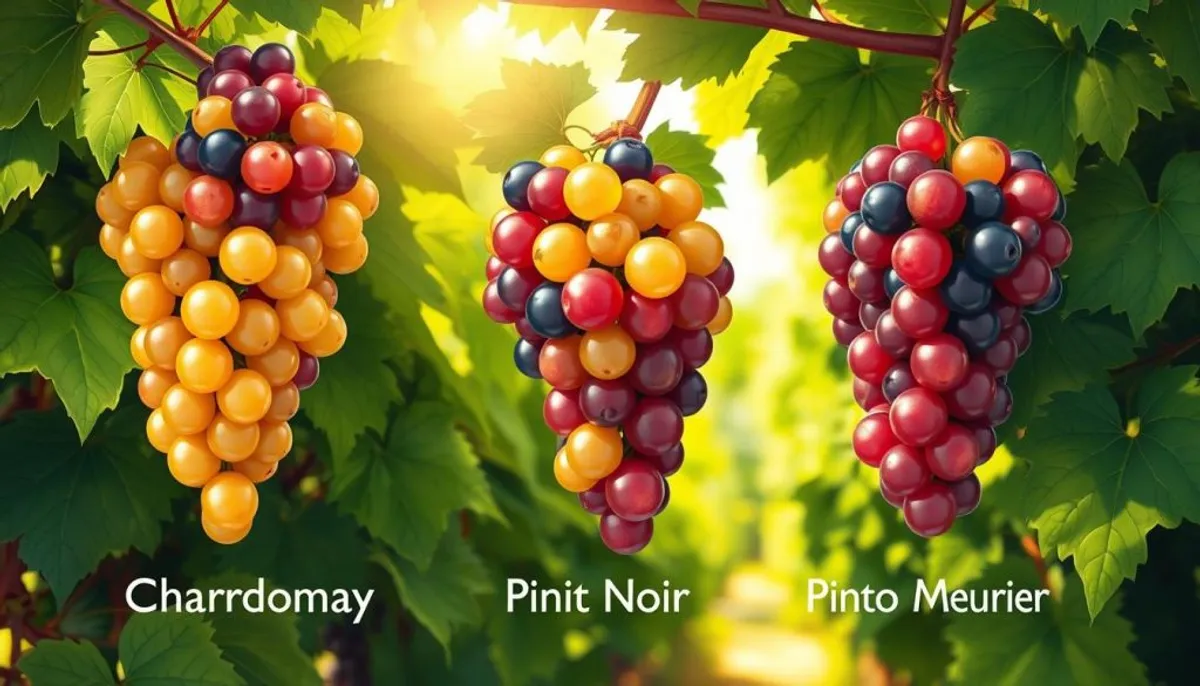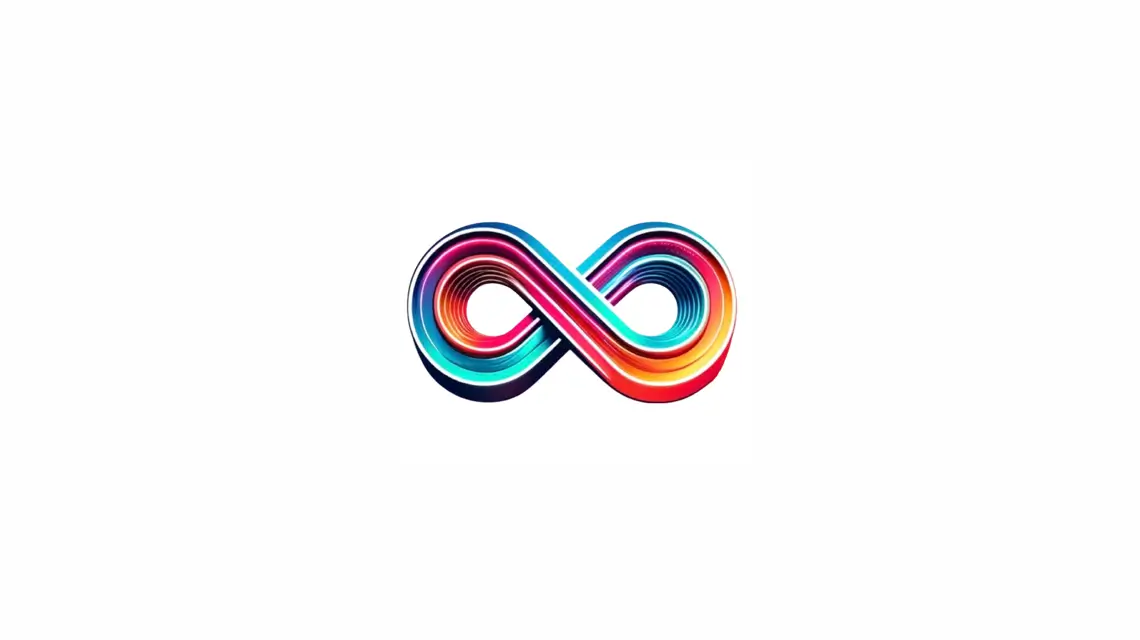Welcome to the realm of luxury champagne, where the finest premium sparkling wines await. This journey will take you from the picturesque hills of France’s Champagne region to your glass. We will uncover the essence of high-end bubbly.

Champagne transcends its role as a beverage, embodying celebration and elegance. Each bottle narrates a tale of tradition, skill, and superiority. Whether you’re an aficionado or new to fine wines, this guide will enhance your appreciation for top-rated champagnes.
Did you know that while a standard champagne bottle holds 750 ml, some rare bottles can hold up to 30 liters? That’s enough to fill 240 glasses! Prices span from $12 for entry-level bottles to over $9,000 for the most exclusive labels. Fear not, as excellent options abound at every price level.
Key Takeaways
- Champagne originates from the Champagne region of France
- It’s crafted using the unique méthode champenoise
- The primary grape varieties are Chardonnay, Pinot Noir, and Pinot Meunier
- Champagne generally contains 12.2% alcohol by volume
- Bottle sizes vary from standard 750ml to rare 30l Melchizedek
- Prices range widely, from affordable to ultra-premium
Understanding Champagne: A Symbol of Luxury
Champagne, a sparkling wine, has been a symbol of luxury and celebration for centuries. Its history is deeply rooted in the Champagne region, where winemaking dates back to the 1st century. Recent discoveries confirm the presence of domestic vines during that era.
What Makes Champagne Special
Champagne’s uniqueness is rooted in its rich heritage and meticulous production process. The region’s prominence began in 496 when Clovis was baptized in Reims. This city later hosted grand coronation banquets for French kings, solidifying Champagne’s status as a luxury wine.
The Protected Designation of Origin
AOC regulations are crucial in preserving Champagne’s exclusivity. These strict rules ensure only sparkling wines from the Champagne region of France can be labeled as “Champagne.” This designation, recognized in 1690, marked a shift from generic “French wines” to region-specific identification.
Traditional Production Methods
The méthode champenoise, Champagne’s traditional production method, showcases the wine’s craftsmanship. Innovations in the 17th and 18th centuries, such as cork stoppers and thicker glass bottles, revolutionized production. The 19th century saw further advancements, including sugar addition for effervescence control and the invention of riddling racks, enhancing consistency and quality.
Today, 80% of Champagne produced is Brut, reflecting a preference for drier styles. Despite challenges like the phylloxera crisis of 1890, Champagne remains the ultimate luxury drink. It symbolizes prestige, quality, and celebration at high-society events worldwide.
Top Rated Champagne Houses and Their Heritage
The Champagne region in France is home to a multitude of prestigious champagne brands. These houses have been perfecting the art of creating luxury bubbles for centuries. Each has its own unique history and style, contributing significantly to the world of fine wine.
Moët & Chandon, founded in 1743, is celebrated for its Dom Pérignon vintage champagne. Veuve Clicquot, established in 1772, holds the distinction of being the first to blend red wine for sparkling rosé. Bollinger, founded in 1829, is renowned for its robust Special Cuvée.
Some champagne houses offer unique experiences. Leclerc Briant, certified biodynamic in the 1980s, invites guests to stay on the famous Avenue de Champagne. Taittinger’s tours showcase endless chalk cellars where millions of bottles age. Boizel in Épernay leads in champagne and food pairing, promoting diverse blends for different courses.
| Champagne House | Founded | Notable Feature |
|---|---|---|
| Moët & Chandon | 1743 | Dom Pérignon vintage champagne |
| Veuve Clicquot | 1772 | First to create sparkling rosé |
| Bollinger | 1829 | Robust Special Cuvée |
| Leclerc Briant | – | Biodynamic certification, guest stays |
| Taittinger | 1734 | Tours of Roman-era chalk cellars |
From the iconic Louis Roederer Cristal to the pure expression of Ruinart Blanc de Blancs, these champagne houses continue to shape the luxury wine landscape. Their commitment to quality, innovation, and tradition ensures that champagne remains a symbol of celebration and refinement. Among the diverse offerings, sweet champagne varieties are particularly favored for their rich flavors and delightful sweetness.
Essential Champagne Grape Varieties
Champagne grapes are the foundation of this exquisite sparkling wine. The region’s terroir and climate foster three primary varieties. These varieties are crucial in defining champagne’s character and complexity.

Chardonnay: The White Grape
Chardonnay excels in Côte des Blancs’ chalky soils. It imparts elegance, citrus notes, and aging potential to champagne. This white grape constitutes 31% of Champagne vineyards, contributing to the wine’s crisp, fresh profile.
Pinot Noir: The Red Pioneer
Pinot Noir is the dominant grape in Champagne, covering 38% of vineyards. It thrives in Montagne de Reims and Côte des Bar. This red grape variety adds body, red fruit aromas, and depth to champagne, enhancing its structure and complexity.
Pinot Meunier: The Supporting Actor
Pinot Meunier, commonly referred to as Meunier, makes up 32% of Champagne’s vineyards. It excels in Marne Valley’s cooler, clay-rich soils. This grape contributes fruitiness, roundness, and softness to blends, ensuring balance and depth.
| Grape Variety | Vineyard Coverage | Key Characteristics |
|---|---|---|
| Chardonnay | 31% | Elegance, citrus notes, aging potential |
| Pinot Noir | 38% | Body, red fruit aromas, complexity |
| Pinot Meunier | 32% | Fruitiness, roundness, softness |
These three grape varieties account for over 99% of Champagne’s vineyards. Their distinct qualities and proportions are responsible for the unique flavors and styles that champagne enthusiasts worldwide adore.
Regional Classifications and Quality Levels
The champagne classification system divides wines into three categories: Grand Cru, Premier Cru, and Autre Cru. This system reflects the quality of grapes from specific villages in the Champagne region.
Grand Cru represents the pinnacle of champagne quality. Only 17 villages in Champagne have earned this prestigious designation, accounting for a mere 5% of the region’s wine-growing communes. These areas are known for producing grapes of exceptional quality.
Premier Cru is the second-highest tier in the champagne classification. It includes 44 communes, making up 15% of Champagne’s vineyards. Grapes from these areas are rated between 90-99% in quality.
Autre Cru encompasses the remaining villages in the Champagne region. While these areas produce quality grapes, they don’t reach the same level as Grand Cru or Premier Cru.
| Classification | Number of Villages | Quality Rating | Price Range (per kilo) |
|---|---|---|---|
| Grand Cru | 17 | 100% | €6.93 – €6.96 |
| Premier Cru | 44 | 90-99% | €6.42 – €6.89 |
| Autre Cru | Remaining | 80-89% | Varies |
This classification system impacts both the price and prestige of champagne, including options like extra dry champagne. Grand Cru grapes command the highest prices, followed by Premier Cru. The system helps consumers understand the quality and value of different champagnes, guiding their purchasing decisions.
Prestigious Champagne Styles and Types
Champagne styles present a spectrum of diversity, each boasting distinct characteristics. From the refined elegance of prestige cuvée to the refreshing crispness of blanc de blancs and the sophisticated allure of extra dry champagne, there exists a champagne suitable for every taste and event.
Prestige Cuvée
Prestige cuvée embodies the zenith of champagne craftsmanship. These elite selections from renowned houses are crafted from the finest grapes and undergo extended aging. Their premium prices, ranging from $70 to $150 or more, underscore their unparalleled quality and scarcity.
Blanc de Blancs
Blanc de blancs, derived from Chardonnay grapes exclusively, offers a refined, crisp taste profile. It is characterized by citrus and mineral notes. Priced between $30 to $50, this champagne complements seafood dishes exceptionally well.
Blanc de Noirs
Blanc de noirs, utilizing only black grapes such as Pinot Noir and Pinot Meunier, presents a more robust champagne. It boasts red fruit flavors, making it a fuller-bodied option. Typically priced between $50 to $100, it stands out for its depth and richness.
Rosé Champagne
Rosé champagne, distinguished by its pink color, is achieved through brief skin contact with black grapes or by incorporating a small red wine portion. Renowned for its fruity taste and striking appearance, it is ideal for festive occasions. Its price range, from $40 to $80, reflects its popularity and appeal.
| Champagne Style | Main Grape(s) | Price Range | Flavor Profile |
|---|---|---|---|
| Prestige Cuvée | Blend | $70 – $150+ | Complex, refined |
| Blanc de Blancs | Chardonnay | $30 – $50 | Crisp, elegant |
| Blanc de Noirs | Pinot Noir, Pinot Meunier | $50 – $100 | Full-bodied, red fruit |
| Rosé | Blend | $40 – $80 | Fruity, vibrant |
Understanding Champagne Sweetness Levels
Champagne sweetness levels are pivotal in shaping its taste profile, ranging from bone-dry to decadently sweet. This spectrum caters to diverse palates, offering a variety of flavors. Let’s dive into the different levels of champagne sweetness and their distinct characteristics.
The sweetness in champagne is a result of the dosage, a blend of wine and sugar added post-second fermentation. This blend affects the wine’s acidity and final flavor. The residual sugar (RS) in the wine determines its sweetness category.
| Sweetness Level | Residual Sugar (g/L) | Calories per 5 oz | Carbs per 5 oz |
|---|---|---|---|
| Brut Nature | 0-3 | 0-2 | Up to 0.15 |
| Extra Brut | 0-6 | 0-6 | Up to 0.9 |
| Brut | 0-12 | 0-7 | Up to 1.8 |
| Extra Dry | 12-17 | 7-10 | 1.8-2.6 |
| Dry (Secco) | 17-32 | 10-19 | 2.6-4.8 |
| Demi-Sec | 32-50 | 19-30 | 4.8-7.5 |
| Doux | 50+ | 30+ | 7.5+ |
Brut champagne, known for its crisp and dry taste, makes up 80-90% of all champagne sales. The growing interest in health has boosted the popularity of Brut Nature or Zero Sugar champagnes in recent years.
On the sweeter side, demi-sec and doux champagnes provide a more indulgent experience. Demi-sec, with 32-50 g/L of added sugar, is perfect for desserts. Doux, the sweetest, contains over 50 g/L of sugar, offering a rich, dessert-like champagne. Additionally, sweet champagne varieties cater to those who enjoy a sweeter palate, enhancing the overall experience.
Whether you lean towards the dry Brut Nature or the sweet Doux, grasping the nuances of champagne sweetness enhances your appreciation. Select your preferred style to enhance your meal or mark special occasions.
Most Exclusive and Legendary Champagne Bottles
The realm of luxury champagne brands is a treasure trove of rare and vintage champagnes, captivating both connoisseurs and collectors. These prestigious bottles embody the pinnacle of craftsmanship and exclusivity within the champagne industry.
Dom Pérignon Vintages
Dom Pérignon, a name synonymous with luxury, produces vintage champagne only in exceptional years. The 1995 vintage, available in a 3-liter Jeroboam, commands an impressive price of over $12,000. This reflects the brand’s unwavering commitment to quality, making each bottle a highly sought-after piece for collectors.
Louis Roederer Cristal
Cristal, originally created for Russian Tsar Alexander II, symbolizes opulence. A bottle of Louis Roederer Cristal Brut 1947 fetched an astounding €14,777 at auction. In 1990, a special luxury cuvée of Cristal saw only 2,000 bottles produced, underscoring its exclusivity among vintage champagnes.
Krug Grande Cuvée
Krug’s dedication to excellence is evident in their Grande Cuvée. The 1928 Krug Collection, priced at €18,700, showcases the brand’s legacy. For true enthusiasts, the Clos d’Ambonnay cuvée, with a limited production of 3,000 bottles and a price tag exceeding $2,500, represents the epitome of rare champagne.
| Champagne | Year | Price |
|---|---|---|
| Louis Roederer Cristal Brut | 1947 | €14,777 |
| Krug Collection | 1928 | €18,700 |
| Dom Pérignon Jeroboam | 1995 | $12,000+ |
Investment-Worthy Champagne Collections
Champagne investment has emerged as a sought-after option for wine enthusiasts. The rare champagne market presents unique opportunities for those aiming to diversify their portfolios with liquid assets. As the champagne market expands, grasping key factors is essential for investors to make well-informed decisions.
Factors Affecting Value
Several elements significantly influence the value of investment-grade champagne. Vintage years, such as 1996 and 2008, are crucial, commanding higher prices. Brand prestige, rarity, and critic scores also play significant roles. For example, a 2008 Krug Vintage Brut saw a remarkable 183% appreciation, rising from $236 to $669.
Storage Requirements
Proper storage is crucial for maintaining champagne’s investment value. Ideal conditions include:
- Cool temperatures around 12°C (54°F)
- High humidity levels
- Dark environment
- Horizontal bottle positioning
Following these guidelines ensures the champagne retains its quality and potential for appreciation.
Market Trends
The champagne investment market has demonstrated remarkable stability and growth. In 2021, the Champagne 50 Liv-ex index surged by 40%, reaching record highs. Exports reached 320 million bottles, a 30% increase from 2020. The market is expected to grow at a CAGR of 6.2% between 2020-2025, showcasing strong potential for investors in the rare champagne market.
| Year | Export Volume (Million Bottles) | Growth Rate |
|---|---|---|
| 2020 | 246 | – |
| 2021 | 320 | 30% |
Perfect Food Pairings with Premium Champagne
Champagne and food pairing is an art that elevates the dining experience. The versatility of champagne makes it a perfect companion for various dishes, creating gourmet pairings that tantalize the taste buds. Let’s explore some exquisite combinations in champagne gastronomy.
Blanc de Blancs champagne, made from white grapes, pairs wonderfully with seafood. Its light body and citrusy notes complement oysters, caviar, and grilled fish. For a luxurious treat, try pairing a Blanc de Blancs with lobster or scallops.
Rosé champagne offers a unique flavor profile that works well with a range of dishes. Its hints of red fruits make it an excellent match for grilled salmon, roasted chicken with herbs, or even pizza. The versatility of rosé champagne in food pairings is truly remarkable.

Blanc de Noirs champagne, crafted from red grapes, pairs excellently with bolder flavors. This style complements steak, lamb, and dark chocolate desserts. The richness of Blanc de Noirs enhances the savory notes in these dishes, creating a harmonious balance.
| Champagne Style | Food Pairing |
|---|---|
| Brut Nature | Lobster, Roast Chicken |
| Extra Brut | Spicy Curry, Apple Pie |
| Brut | Steak, Fried Chicken, Shellfish |
| Extra Dry | Sushi, Spicy Food, Fruit Pastries |
| Demi-sec | Foie Gras, Chocolate Pudding, Cheese |
The sweetness level of champagne also plays a crucial role in food pairings. Brut champagne, with its dry profile, pairs well with a wide range of foods from oysters to cheese platters. Demi-sec champagne, being sweeter, complements desserts and spicy dishes beautifully.
How to Store and Serve Luxury Champagne
Proper storage and serving techniques are crucial for preserving the quality and flavor of luxury champagne. Let’s explore the optimal methods to ensure you enjoy your champagne at its best.
Optimal Temperature Guidelines
The champagne serving temperature plays a vital role in enhancing its taste. For the best experience, serve champagne between 8°C and 10°C. This temperature range allows the flavors to shine while maintaining the perfect effervescence. Refrigerator temperature (5-9°C) is suitable for short-term storage before serving.
Proper Glass Selection
Choosing the right glassware is essential for savoring luxury champagne. Tulip-shaped champagne flutes are ideal as they preserve bubbles and concentrate aromas. These glasses allow for better aeration, enhancing the overall tasting experience. Before use, rinse the glasses with hot water and let them air dry to avoid leaving any residue.
Storage Conditions
Proper champagne storage is key to maintaining its quality over time. Store bottles horizontally in a cool, dark place with stable humidity (70-85%). The ideal storage temperature ranges from 10°C to 13°C. Avoid temperature fluctuations and exposure to light, which can negatively impact the champagne’s flavor and aroma.
| Champagne Type | Optimal Storage Duration | Ideal Storage Temperature |
|---|---|---|
| Non-vintage | 3-4 years | 10°C-13°C |
| Vintage | 5-15 years | 10°C-13°C |
| Magnum (1.5L) | Longer aging potential | 10°C-13°C |
By following these guidelines for champagne serving temperature, using appropriate champagne flutes, and maintaining proper champagne storage conditions, you’ll ensure that every sip of your luxury champagne is a delightful experience.
Conclusion
This luxury champagne guide has embarked you on a journey through the elite realm of top-rated champagne. We’ve explored the distinct production methods and highlighted prestigious houses like Moët & Chandon and Veuve Clicquot. This journey has revealed the core of champagne appreciation.
Our exploration has touched upon the subtleties of various champagne styles, from the exclusive Blanc de Blancs to the rich Blanc de Noirs. It’s crucial to note that serving temperatures significantly impact the taste. Young champagnes are best at 8-10°C, while mature vintages should be served at 10-12°C. For the finest experience, use tulip-shaped glasses to fully appreciate your chosen cuvée.
Whether you’re indulging in a bottle of Krug Vintage 1996 (rated 98 points) or savoring a more accessible André Clouet Brut Grand Reserve, champagne caters to all tastes and events. As you continue your champagne exploration, remember that true appreciation stems from exploring diverse styles and finding your personal favorites in this luxurious world of bubbles.
RelatedRelated articles



